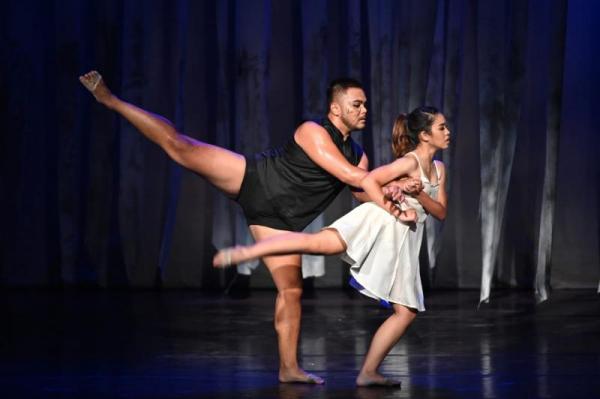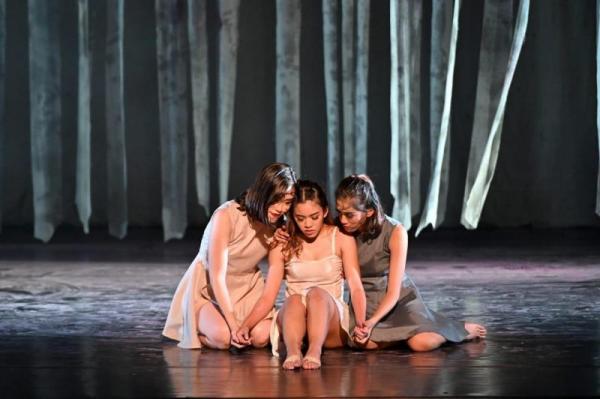Review: KINTSUGI's Beautiful Yet Shocking Portrayal of An Abusive Relationship Impresses

On May 23rd, a new contemporary ballet show, KINTSUGI, ran for one show only at Teater Kecil, Jakarta. It is the brainchild of dancer Elhaq Latief under the banner of ELHAQ LATIEF PRODUCTION and tells the story of a romance that devolves into an abusive relationship. The show is followed with a discussion session with National Commission on Violence Against Women, Komnas Perempuan, and abuse survivor advocacy foundation, Yayasan Pulih.
Structurally, KINTSUGI is a ballet told in three movements (preceded by a prologue), all set to Russian composer Sergei Rachmaninoff's Piano Concerto No. 2 in C Minor. The usage of a three-act structure lends a narrative cohesiveness towards the heavy subject matter. The show as a whole is easy to follow despite the gut-churning themes, allowing viewers to easily take in the story for the post-show discussion session.
KINTSUGI opens with a darkly lit prologue, depicting the domestic life of three people: the Father (Arfan Rizki), the Mother (Novita Liling), and the Boy (Elhaq Latief). The harrowing scene serves as a foreshadowing of the things to come; the Father and Mother engage in physical scuffles while a helpless Boy looks on in silence from a corner. The parents notably don't interact with the Boy, leaving him with his own thoughts, trying to make sense of the violence unfolding in front of him.
The first movement depicts the first meeting between The Boy and The Girl (Nadhira Nasution) with them dressed in black and white, respectively. The choice of color in both costume and lighting throughout the production has obvious symbolism while also creating striking contrast in many scenes.

When she first enters, the Girl is seen reading a book, codifying her as the introverted one in the relationship. She moves with both grace and a certain dreamy naiveté, while the Boy moves in reassured thrusts and swings. Their courtship started sweet and beautiful with a joyous couple choreography involving intimate lifts and energetic leaps set in pink illumination. Shades of discontent appear in the way the Girl expresses reluctance at being introduced to the Boy's circle of friends, but her lover keeps his literal pull on her.
The Boy excitedly brings The Girl home to meet the Mother; contrary to the pleasant meeting he may imagine, his mother expresses obvious disapproval and a hint of bitterness. In a fit of rage, the Boy hits the Mother. The Girl flees, horrified.
The realization of his action leaves the Boy wallowing in the darkness of his regret. Salvation comes with the Girl, who checks up on him and seemingly forgives his momentary madness. The accompanying dance is appropriately sober and solemn.

Their moment of respite turns out to be a brief one as the Sidechick (Neala Vangelin) appears before the Boy. Sensuous and alluring, the Boy shows little resistance before taking her into an adulterous dance. The Girl shortly appears, dejected; the Boy aloofly flounces off with his new partner. Another man, the Lover (Indonesia Menuju Broadway alumnus Aldafi Adnan), walks in and consoles the heartbroken Girl. They too dance a duet.
Unexpectedly, the Boy comes back and tries to tear the Girl away. This time, she stands her ground and tells the Boy to go away. The Girl and the Lover resume their gentle couple number. Alone once more, the Boy looks at the people in his life who shape him: the Father, the Girl, the Sidechick, the Lover, and the Mother.
As their lives go on apart from each other, the Girl moves forward with her life while the Boy dwells in his rage. This moment is portrayed through a sequence where their steps mirror each other; the black and white costumes further build the yin yang imagery.
.jpeg/WhatsApp%20Image%202019-08-12%20at%2020_12_53%20(1)__600x400.jpeg)
Without a warning, their paths cross once more. The Boy immediately assaults the Girl with a series of vicious moves. This segment is particularly intense, mercilessly emulating various forms of violence. Only after he hunches over in fatigue does the Boy show remorse, hugging the Girl tightly in a display of regret. He pleads with her as she tries to get away from him. Although this works for some time as the Girl herself is torn between breaking off the toxic relationship or allowing it to continue, the problematic back-and-forth ends by the Girl pointing away, telling the Boy to leave for good.
Before long, the Girl's two friends come to comfort her as the light changes from a loud red to a somber and dim white. In the final part of the show, figures surround the Girl with their arms on each other's shoulder, standing behind her as they look up towards the light.

Even today, the topic of abusive relationships is still a taboo in Indonesia. Abuse survivors are often branded culpable because of their action in inciting violence or inaction in leaving their situation. Elhaq Latief draws from his personal experience to weave a tale that's easy to follow yet satisfyingly nuanced, giving back the survivors their rightful voice. He portrays such toxic relationship as complicated, where the abuser may plead for their victim not to leave, knowingly or unknowingly manipulating them through show of regret.
Yet he also gave spotlight to the abuser; the Boy's tale is a harrowing cautionary tale not only from his side as the perpetuator of violence but also the people around him. A parent's violent outburst at home can leave scar on a child's malleable mind, while a social circle's unwillingness to interfere in an unhealthy relationships can make them implicit in allowing further abuses.
.jpeg/WhatsApp%20Image%202019-08-12%20at%2020_12_54%20(1)__600x399.jpeg)
KINTSUGI chose to tell a story of a duality; as it tells not only the abused's but also the abuser's side of their story, it engages the viewers to consider themselves as both potential victim and potential perpetrator due to our inherent capacity for good and evil. But it should be noted that although the story starts with the Boy as the point of view character, the story ends with the Girl starting her recovery. This creates a poetic effect as we leave the Boy's negativity and stands with the Girl, hurt as she may be.
Even with the weighty discourse, Elhaq never fails to take into account the show's value as art and entertainment. KINTSUGI is a master class in conveying a story through motion. Dance can be a particularly hard medium to digest for the casual viewer, as the motions are abstraction of a story's narrative and emotional beats. But Elhaq Latief's choreography successfully toes the fine line between obvious and abstruse; it is evocative without obfuscating the character's actions and emotions.
The show particularly excels at transitioning seamlessly between the physical and mental realm. It can tell a real happening in one moment and delve into the character's psyche the next. All transitions are smooth without a noticeable break in the flow of the show, creating a sense of immersion as the story unfolds in real time.
Another big theme is how people are shaped through their experience with people closest to them as well as the larger society. The Boy learned violence from his parents while his standoffish friends don't call him out on his attitude problems. Meanwhile, the Girl's two best friends accompany her through highs and lows and the Lover has introduced her to a gentler kind of love. These people eventually pave the way that the main characters take in the end.
.jpeg/WhatsApp%20Image%202019-08-12%20at%2020_12_53%20(2)__600x399.jpeg)
Of course the lofty concept and choreography would have fallen flat without the appropriate talent. Elhaq Latief's portrayal of the confused and aggressive Boy is a departure from his usual role as a protagonist, but the raw anger and sorrow he expressed throughout the show are understandably authentic. Meanwhile, Nadhira's lithe and innocent the Girl is instantly charming and makes her downfall all the more tragic. Elhaq's choice of partner role is highly inspired, as even the mere contrasting physicality can make the stage buzz with anticipatory energy.
The supporting characters and dance ensemble also help in bringing the show together. Their presence - sometimes loud and taking center stage, sometimes merely cameos - are efficiently used, without extraneous portion when unneeded. Many of the names are already well-known within the Jakarta musical theater community, bringing the required experience to coordinate the group movements.
The minimalist but meaningful production design helps underline the show's theatricality. By using paper and wood and monochromatic lighting and costumes, the production designers (set by Cahaya Lituhayu and Reigina Tjahaja, lighting by Winson Chaivin, and costume by Bartolomeus Putra) imbue a sense of elegance into the production.
KINTSUGI is an honest portrait of humanity, of how people can break each other but also pull each other together. Just as the Japanese art of mending things with lacquer and gold that inspires its name, KINTSUGI proves that our scars do not have to be hidden. Instead, they can be the evidence of mankind's power to push forward and carry our wounds as our stronger surviving selves.
Color photos by Feri Latief, black and white photos by Judith.
Add Your Comment
Videos
